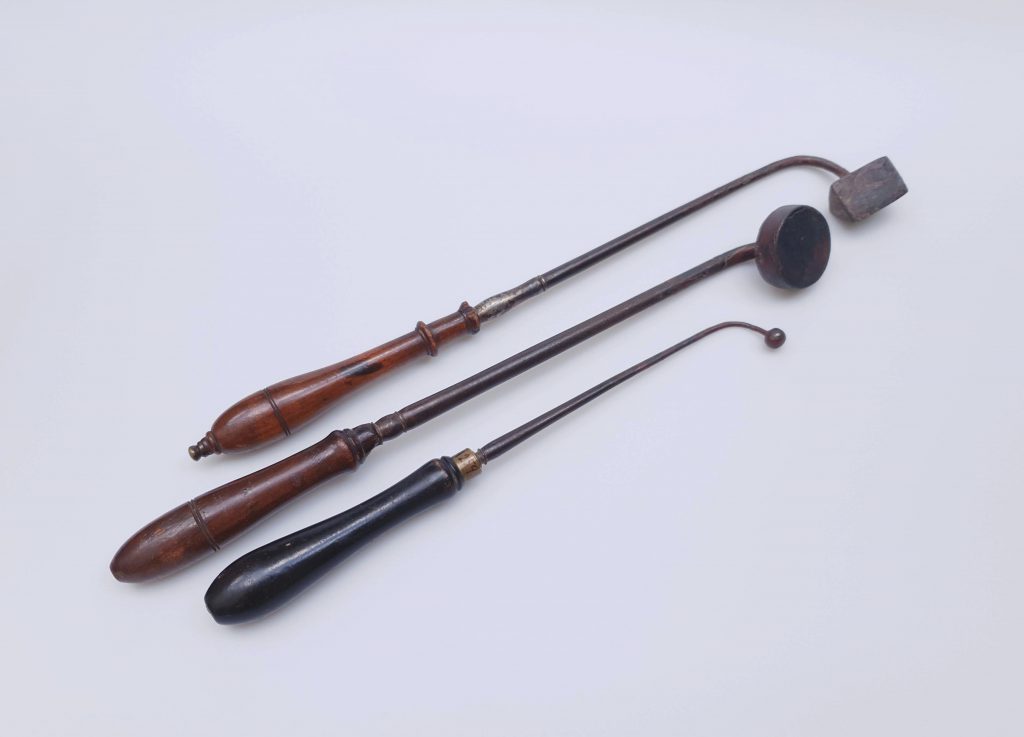
Surgical cautery, iron and wood, Austria, 18th Century. NML Medical Museum, Acological Cabinet, A 234. Photography by Tereza Vobecká
Object of the Month: June 2022
Cautery to Stop Haemorrhage and to Cure Plague
From the Exhibition Plagues 1521-2021 in the NML Medical Museum
Quae medicamenta non sanant, ferrum sanat. Quae ferrum non sanat, ignis sanat. Quae vero ignis non sanat, insanabilia reputari oportet.
That which medicines cannot cure, iron [knife] cures. That which iron cannot cure, fire cures. That which fire cannot cure, must be considered incurable.
Last aphorism of Hippocrates (7.87)

Hans Wechtlin, cauterization, woodcut, early 16 century. Published in Hans Gersdorff, Feldtbuch der Wundtarzney (Strassbourg: H. Schott, 1530) Wellcome Collection
During European plague epidemics, much of the medical care was in the hands of surgeons, who concentrated on treating the external symptoms of the disease, such as boils (buboes), swellings of lymph nodes, as well as carbuncles, blisters with black, necrotized tissue underneath. Some patients experienced only the former or the latter, in others both developed. Boils were understood as the way the body rids of the “plague poison”: they were not to be removed like other ulcerations, but one helped them to rupture and transform poison into pus. Poultices softened the boils, and if they did not empty and heal, the surgeon had to open them with a scarificator, a scalpel, corrosives, hot ashes, or hot iron. This allowed the pus to drain away and prevented the poison from entering the veils and causing sepsis.
Cauteries with wooden handles existed since Antiquity, as instruments for stopping bleeding, removing varicose veins, drying infected tissue, and cauterizing tumors and ulcers. With a cautery, a plague boil was opened, removed, and cleaned. Cauterization supposedly stopped the spread of poisoning and for Hippocratic medicine, it was the last resort in the treatment of internal diseases as well. The Roman physician Celsus (25 BCE- 50 CE) or Paul of Aegina (625-690) applied a cautery to the patient’s head to cure epilepsy, Arabic physicians of the 9th and 10th Centuries advised lightly touching the skin just below the collarbone with a red hot iron to alleviate breathing difficulties. To treat stroke, Johannes Scultetus (1595-1645) applied the instrument to the back of the neck, others between the first two cervical vertebrae, Domenico Mistichelli (1675-1715) cauterized the soles of a patient’s feet.
Medieval medicine preferred cauterizing wounds to suturing. Ambroise Paré (1510-1590) pointed out the trauma caused by a cautery and devised a new method of suturing wounds using a clamp, strong double thread, and a pad placed on the wound beneath the knot. Surgeons until the 18th century, however, remained concerned with damage to vesicles by tight stitches and secondary infection from the thread. In the mid-19th century, gas and electrical cauteries were introduced, but cylindrical metal cauteries remained in use at least until the 1870, and smaller cauteries for stopping bleeding after hemorrhoid surgery until around 1900.
In his 1731 textbook on surgery, Lorenz Heister (1683-1758) explained how to recognize a plague boil or a carbuncle from other ulcerous and cancerous growths. Heister bespread the buboes with plasters, such as emplastrum diachylon with lead and pork fat or plasters made with exotic resins galbanum and carana, blended with tar and chamomile; he coated them with yeast, applied onions baked in ashes and mixed with theriac and butter or bread cooked in milk. In his Advice against the Plague (Adversus pestem consilium, 1614), Johann Jessenius (1566-1621) recommended covering the wound with salted horseradish; other recipes featured dried toads and various excrements. Carbuncles, which indicated a glut of infected blood, were to be opened or singed and cleaned straight away. If the tissue necrotized, cauterization should not be overly painful and had many advocates: Nathaniel Hodges (1629-1688), during the Plague of London, knew no better treatment method. Heister was aware of the pain caused by the cautery and remarked that, leaving aside other contraindications, “patients do not endure it lightly.” Once the boil or the carbuncle was opened or burned, various healing potions were applied, such as Peruvian balsam or balsamus arcei, a mixture of resins with goat tallow and pork fat.

Cauteries were usually made of iron, a good transmitter of heat, with a wooden handle to protect the surgeon’s hand. From the left a cautery after J. N. Rust (1775-1840), with a prism/shaped head, and common spherical or cylindrical cauteries of varied size for different operations. NML Medical Museum, Acological Cabinet, A 236, A 259, A 234